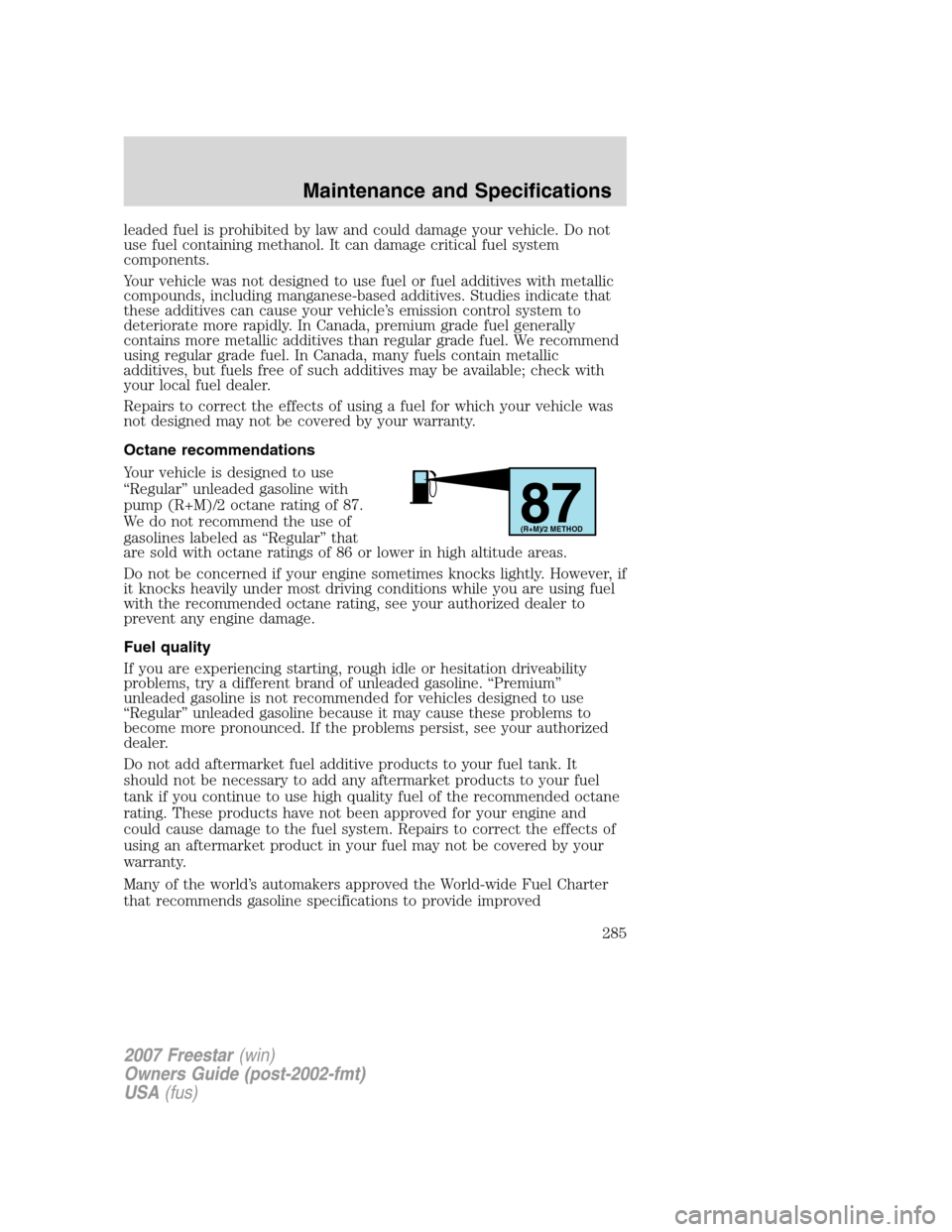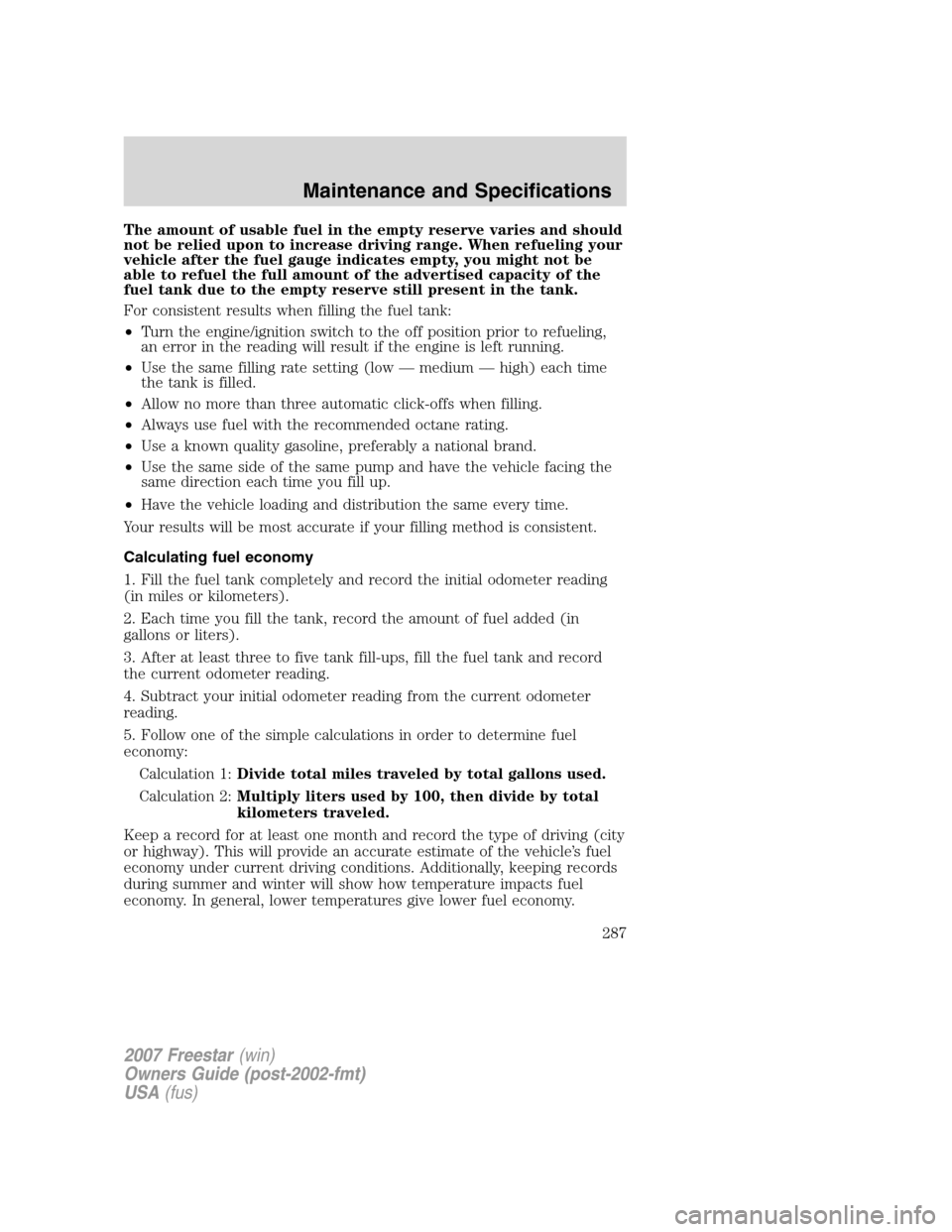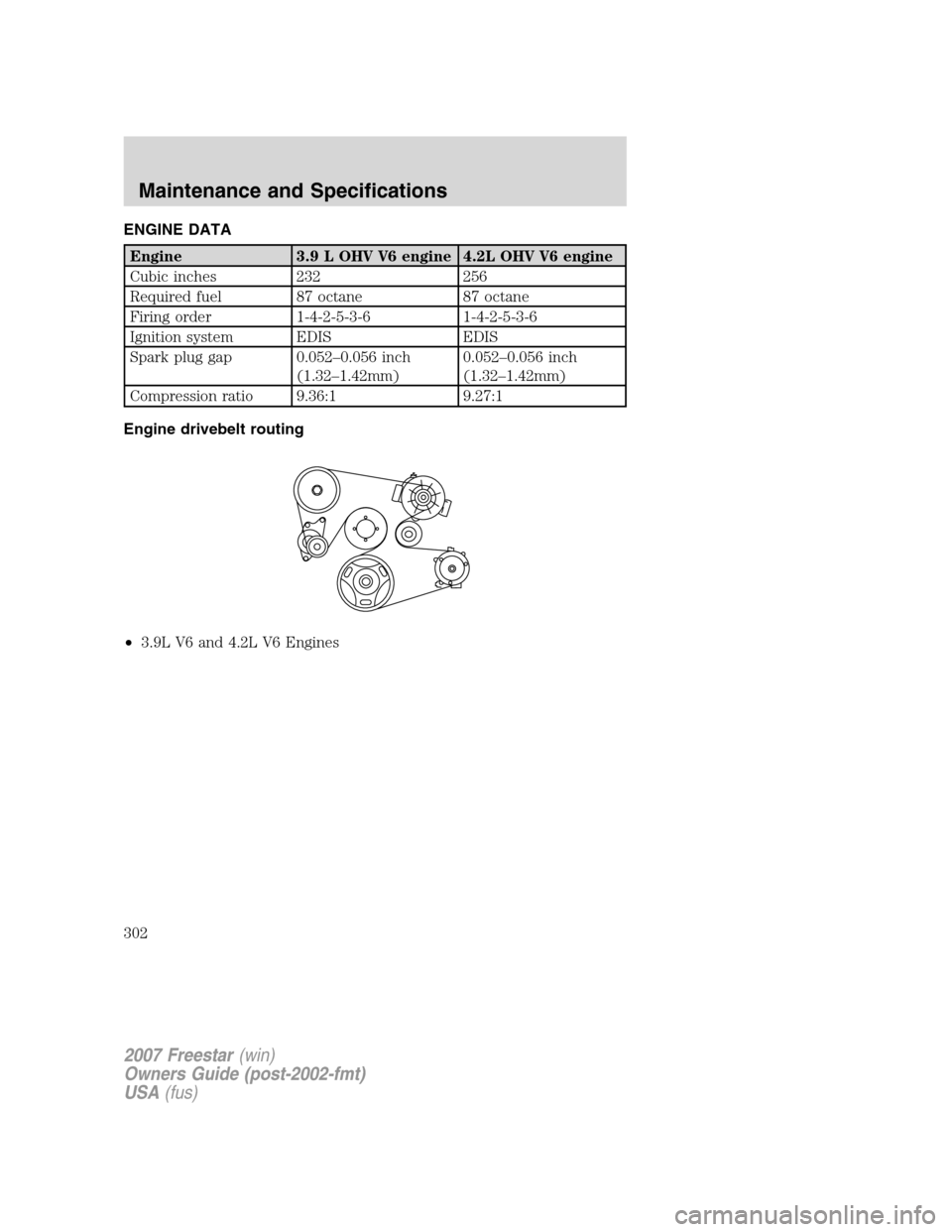2007 FORD FREESTAR octane
[x] Cancel search: octanePage 285 of 312

leaded fuel is prohibited by law and could damage your vehicle. Do not
use fuel containing methanol. It can damage critical fuel system
components.
Your vehicle was not designed to use fuel or fuel additives with metallic
compounds, including manganese-based additives. Studies indicate that
these additives can cause your vehicle’s emission control system to
deteriorate more rapidly. In Canada, premium grade fuel generally
contains more metallic additives than regular grade fuel. We recommend
using regular grade fuel. In Canada, many fuels contain metallic
additives, but fuels free of such additives may be available; check with
your local fuel dealer.
Repairs to correct the effects of using a fuel for which your vehicle was
not designed may not be covered by your warranty.
Octane recommendations
Your vehicle is designed to use
“Regular” unleaded gasoline with
pump (R+M)/2 octane rating of 87.
We do not recommend the use of
gasolines labeled as “Regular” that
are sold with octane ratings of 86 or lower in high altitude areas.
Do not be concerned if your engine sometimes knocks lightly. However, if
it knocks heavily under most driving conditions while you are using fuel
with the recommended octane rating, see your authorized dealer to
prevent any engine damage.
Fuel quality
If you are experiencing starting, rough idle or hesitation driveability
problems, try a different brand of unleaded gasoline. “Premium”
unleaded gasoline is not recommended for vehicles designed to use
“Regular” unleaded gasoline because it may cause these problems to
become more pronounced. If the problems persist, see your authorized
dealer.
Do not add aftermarket fuel additive products to your fuel tank. It
should not be necessary to add any aftermarket products to your fuel
tank if you continue to use high quality fuel of the recommended octane
rating. These products have not been approved for your engine and
could cause damage to the fuel system. Repairs to correct the effects of
using an aftermarket product in your fuel may not be covered by your
warranty.
Many of the world’s automakers approved the World-wide Fuel Charter
that recommends gasoline specifications to provide improved
87(R+M)/2 METHOD
2007 Freestar(win)
Owners Guide (post-2002-fmt)
USA(fus)
Maintenance and Specifications
285
Page 287 of 312

The amount of usable fuel in the empty reserve varies and should
not be relied upon to increase driving range. When refueling your
vehicle after the fuel gauge indicates empty, you might not be
able to refuel the full amount of the advertised capacity of the
fuel tank due to the empty reserve still present in the tank.
For consistent results when filling the fuel tank:
•Turn the engine/ignition switch to the off position prior to refueling,
an error in the reading will result if the engine is left running.
•Use the same filling rate setting (low — medium — high) each time
the tank is filled.
•Allow no more than three automatic click-offs when filling.
•Always use fuel with the recommended octane rating.
•Use a known quality gasoline, preferably a national brand.
•Use the same side of the same pump and have the vehicle facing the
same direction each time you fill up.
•Have the vehicle loading and distribution the same every time.
Your results will be most accurate if your filling method is consistent.
Calculating fuel economy
1. Fill the fuel tank completely and record the initial odometer reading
(in miles or kilometers).
2. Each time you fill the tank, record the amount of fuel added (in
gallons or liters).
3. After at least three to five tank fill-ups, fill the fuel tank and record
the current odometer reading.
4. Subtract your initial odometer reading from the current odometer
reading.
5. Follow one of the simple calculations in order to determine fuel
economy:
Calculation 1:Divide total miles traveled by total gallons used.
Calculation 2:Multiply liters used by 100, then divide by total
kilometers traveled.
Keep a record for at least one month and record the type of driving (city
or highway). This will provide an accurate estimate of the vehicle’s fuel
economy under current driving conditions. Additionally, keeping records
during summer and winter will show how temperature impacts fuel
economy. In general, lower temperatures give lower fuel economy.
2007 Freestar(win)
Owners Guide (post-2002-fmt)
USA(fus)
Maintenance and Specifications
287
Page 302 of 312

ENGINE DATA
Engine 3.9 L OHV V6 engine 4.2L OHV V6 engine
Cubic inches 232 256
Required fuel 87 octane 87 octane
Firing order 1-4-2-5-3-6 1-4-2-5-3-6
Ignition system EDIS EDIS
Spark plug gap 0.052–0.056 inch
(1.32–1.42mm)0.052–0.056 inch
(1.32–1.42mm)
Compression ratio 9.36:1 9.27:1
Engine drivebelt routing
•3.9L V6 and 4.2L V6 Engines
2007 Freestar(win)
Owners Guide (post-2002-fmt)
USA(fus)
Maintenance and Specifications
302
Page 309 of 312

capacity ...................................300
choosing the right fuel ...........284
comparisons with EPA fuel
economy estimates .................289
detergent in fuel .....................286
filling your vehicle
with fuel ..................281, 283, 286
filter, specifications ........281, 299
fuel pump shut-off switch .....227
improving fuel economy ........286
octane rating ...................285, 302
quality ......................................285
running out of fuel .................286
safety information relating
to automotive fuels ................281
Fuses ..................................227–228
G
Gas cap (see Fuel cap) ............283
Gas mileage
(see Fuel economy) .................286
Gauges .........................................16
H
Hazard flashers .........................226
Head restraints .................113, 117
Headlamps ...................................45
aiming ........................................48
autolamp system .......................45
bulb specifications ....................51
daytime running lights .............46
flash to pass ..............................46
high beam .................................46
replacing bulbs .........................52
turning on and off ....................45
Heating
heating and air conditioning
system .................................35–36Homelink wireless control
system ..........................................74
Hood ..........................................268
I
Ignition ...............................211, 302
Illuminated visor mirror .............57
Infant seats
(see Safety seats) .....................171
Inspection/maintenance
(I/M) testing ..............................291
Instrument panel ........................65
cleaning ...................................263
cluster ........................................10
lighting up panel and
interior .......................................47
J
Jump-starting your vehicle ......245
K
Keyless entry system ...............106
autolock .....................................96
keypad .....................................107
locking and unlocking
doors ........................................108
programming entry code .......107
Keys .............................95, 109–110
positions of the ignition .........211
L
Lamps
autolamp system .......................45
bulb replacement
specifications chart ..................51
daytime running light ...............46
2007 Freestar(win)
Owners Guide (post-2002-fmt)
USA(fus)
Index
309
Page 310 of 312

headlamps .................................45
headlamps, flash to pass ..........46
instrument panel, dimming .....47
interior lamps .....................49–51
replacing bulbs ...................52, 55
Lane change indicator
(see Turn signal) ........................49
Liftgate ............................87–88, 92
remote release ..................95, 101
Lights, warning and indicator ....10
anti-lock brakes (ABS) ..........215
Load limits .................................200
Locks
autolock .....................................96
childproof ..................................98
doors ..........................................95
Lubricant specifications ...........300
Lug nuts ....................................245
Luggage rack ...............................92
Lumbar support, seats .............115
M
Message center .....................78–79
english/metric button ...............81
system check button ................81
warning messages .....................82
Mirrors .........................................69
automatic dimming rearview
mirror ........................................69
fold away ...................................70
heated ........................................70
programmable memory ..........102
side view mirrors (power) .......69
signal .........................................70
Motorcraft parts ........265, 281, 299
O
Octane rating ............................285Oil (see Engine oil) ..................271
Overdrive ...................................220
P
Parking brake ............................216
Parts (see Motorcraft parts) ....299
Passenger Occupant
Classification Sensor .................139
Pedals (see Power
adjustable foot pedals) ...............71
Power adjustable foot pedals .....71
Power distribution box
(see Fuses) ...............................231
Power door locks ..................95–96
Power liftgate ......................88, 101
Power mirrors .............................69
Power point .................................66
Power steering ..........................218
fluid, checking and adding ....292
fluid, refill capacity ................300
fluid, specifications .................300
Power Windows ...........................67
R
Radio ..........................19, 21, 24, 27
Relays ........................................227
Remote entry system .........98, 100
illuminated entry ............104–105
locking/unlocking
doors ................................100–101
panic alarm .............................102
replacement/additional
transmitters .............................103
replacing the batteries ...........103
Reverse sensing system ...........222
2007 Freestar(win)
Owners Guide (post-2002-fmt)
USA(fus)
Index
310